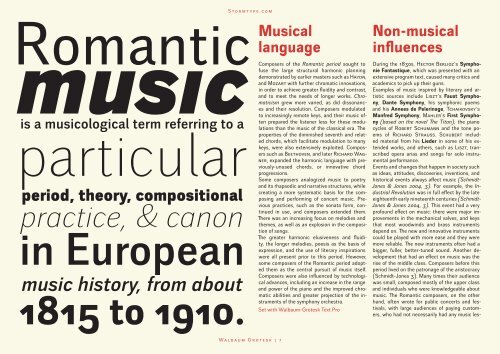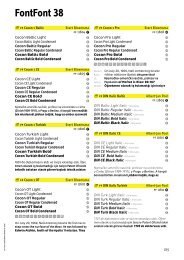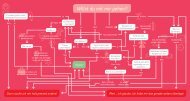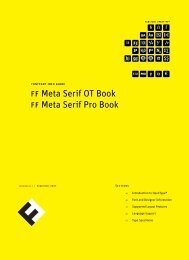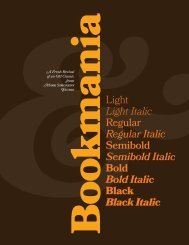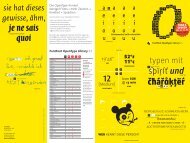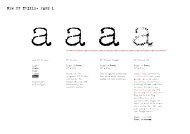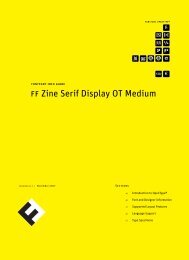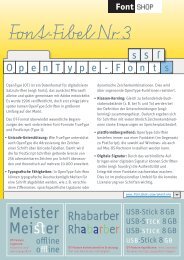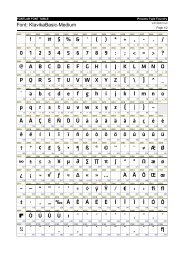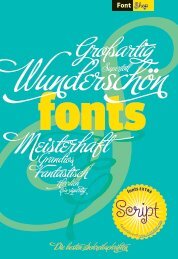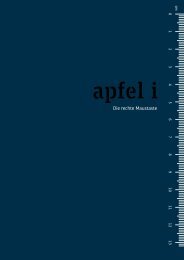Create successful ePaper yourself
Turn your PDF publications into a flip-book with our unique Google optimized e-Paper software.
Stormtype.com<br />
Romantic<br />
musıc<br />
is a musicological term referring to a<br />
particular<br />
period, theory, compositional<br />
practice, & canon<br />
in European<br />
music history, from about<br />
1815 to 1910.<br />
Musical<br />
language<br />
Composers of the Romantic period sought to<br />
fuse the large structural harmonic planning<br />
demonstrated by earlier masters such as Haydn,<br />
and Mozart with further chromatic innovations,<br />
in order to achieve greater fluidity and contrast,<br />
and to meet the needs of longer works. Chromaticism<br />
grew more varied, as did dissonances<br />
and their resolution. Composers modulated<br />
to increasingly remote keys, and their music often<br />
prepared the listener less for these modulations<br />
than the music of the classical era. The<br />
properties of the diminished seventh and related<br />
chords, which facilitate modulation to many<br />
keys, were also extensively exploited. Composers<br />
such as Beethoven, and later Richard Wagner,<br />
expanded the harmonic language with previously-unused<br />
chords, or innovative chord<br />
progressions.<br />
Some composers analogized music to poetry<br />
and its rhapsodic and narrative structures, while<br />
creating a more systematic basis for the composing<br />
and performing of concert music. Previous<br />
practices, such as the sonata form, continued<br />
in use, and composers extended them.<br />
There was an increasing focus on melodies and<br />
themes, as well as an explosion in the composition<br />
of songs.<br />
The greater harmonic elusiveness and fluidity,<br />
the longer melodies, poesis as the basis of<br />
expression, and the use of literary inspirations<br />
were all present prior to this period. However,<br />
some composers of the Romantic period adopted<br />
them as the central pursuit of music itself.<br />
Composers were also influenced by technological<br />
advances, including an increase in the range<br />
and power of the piano and the improved chromatic<br />
abilities and greater projection of the instruments<br />
of the symphony orchestra.<br />
Set with Walbaum-Grotesk Text Pro<br />
Non-musical<br />
influences<br />
During the 1830s, Hector Berlioz’s Symphonie<br />
Fantastique, which was presented with an<br />
extensive program text, caused many critics and<br />
academics to pick up their guns.<br />
Examples of music inspired by literary and artistic<br />
sources include Liszt’s Faust Symphony,<br />
Dante Symphony, his symphonic poems<br />
and his Annees de Pelerinage, Tchaikovsky’s<br />
Manfred Symphony, Mahler’s First Symphony<br />
(based on the novel The Titan), the piano<br />
cycles of Robert Schumann and the tone poems<br />
of Richard Strauss. Schubert included<br />
material from his Lieder in some of his extended<br />
works, and others, such as Liszt, transcribed<br />
opera arias and songs for solo instrumental<br />
performance.<br />
Events and changes that happen in society such<br />
as ideas, attitudes, discoveries, inventions, and<br />
historical events always affect music (Schmidt-<br />
Jones & Jones 2004, 3). For example, the Industrial<br />
Revolution was in full effect by the late<br />
eighteenth early nineteenth centuries (Schmidt-<br />
Jones & Jones 2004, 3). This event had a very<br />
profound effect on music: there were major improvements<br />
in the mechanical valves, and keys<br />
that most woodwinds and brass instruments<br />
depend on. The new and innovative instruments<br />
could be played with more ease and they were<br />
more reliable. The new instruments often had a<br />
bi<strong>gg</strong>er, fuller, better-tuned sound. Another development<br />
that had an effect on music was the<br />
rise of the middle class. Composers before this<br />
period lived on the patronage of the aristocracy<br />
(Schmidt-Jones 3). Many times their audience<br />
was small, composed mostly of the upper class<br />
and individuals who were knowledgeable about<br />
music. The Romantic composers, on the other<br />
hand, often wrote for public concerts and festivals,<br />
with large audiences of paying customers,<br />
who had not necessarily had any music les-<br />
Walbaum Grotesk | 7


